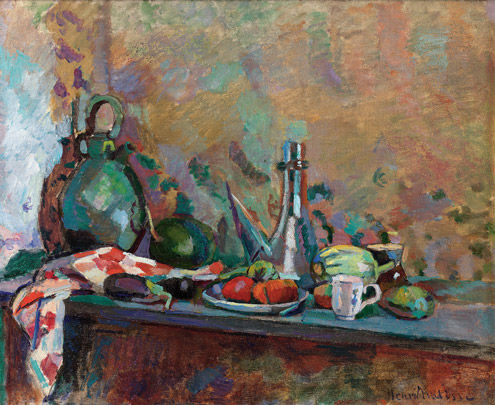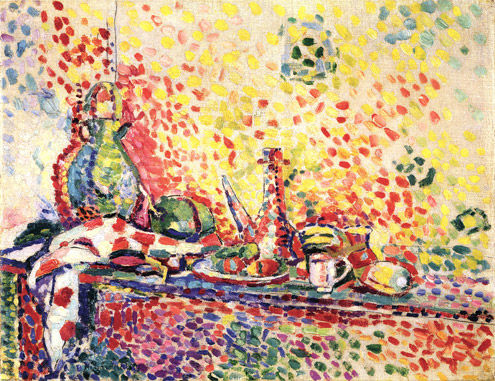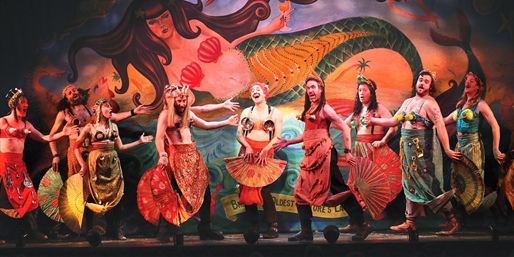After a morning jaunt up to the northern tip of the island to visit old friends and grab a bite to eat, your intrepid travelers repair to the Metropolitan Museum of Art on Fifth Avenue to take in the latest shows. On display are George Bellows, Matisse – In Search of True Painting, Extravagant Inventions – The Princely Furniture of the Roentgens and Faking It – Manipulated Photography Before Photoshop.

42 Kids - George Bellows (1907)
My favorite has to be the Bellows. His work is so American in its nature, so egalitarian, accessible, visceral, genuine. This retrospective is satisfying and complete feeling, but at 120 paintings, not too excessive. From the first, 42 Kids (1907), showing the children of immigrants swimming in the East River, to the final portraits painted before his early death, this collection shows the work of George Wesley Bellows (1881 – 1925) in its fullness. A member of the “Ashcan School” of American Realist painters, and associated with Robert Henri’s “The Eight,” Bellows expressed his leftist, populist leanings in his work, which often focused on the impoverished immigrant population of New York.

Stag At Sharkeys - George Bellows (1909)
He is perhaps best known for his boxing paintings, including the seminal work, Stag At Sharkeys (1909), as well as Both Members Of This Club (1909) and Dempsey And Firpo (1924 – painted for Look Magazine), but Bellows also painted broadly of the scenery and characters of New York — from fishermen and dock workers to the excavation of Pennsylvania Station — and portraits of family, friends and patrons.

New York - George Bellows (1911)
Matisse, on the other hand, never went in much for realism, but sought in abstraction and impression the truest representations of his subjects, be they people, plants or still life. In this exhibit, especially, Matisse’s explorations and experimentation with different representational forms is put before us at once. We see as he studies a subject, and tries different approaches to find the best, or some best, way to depict it. At times we may see 4 or 5 studies of the same subject, abstract, boldly impressionistic, even realistic. I have seen so many Matisse exhibitions at this point — starting with the exhaustive (and exhausting) MoMA retrospective from 1991 (440 pieces) that there is little of his work which I haven’t seen at least several times, but here, at least, we are told a different story about how he settled on the path he did. Well curated, to say the least.

Still Life with Purro I - Henri Matisse (1904)

Still Life with Purro II - Henri Matisse (1904-5)
The furniture of the Roentgen’s is peculiar and certainly of its time. For roughly 60 years, from 1742 in to the beginning of the 19th century, the cabinet making firm of Abraham Roentgen and his son David turned out some of the most ingenious, extravagant and beautiful desks, curious, tables and clocks. A hallmark of their work, in addition to expert joinery and unbelievable inlays, was clever mechanisms. Hidden cubbies, secret lockers, counter-balanced mechanical systems are everywhere. A desk becomes a backgammon table becomes a chess board becomes a card table. A roll top desk has dozens of secret places to store everything from papers to inks and pens. A touch of a hidden button or turn of a key reveals an entire raft of drawers and lined compartments. Astonishing!

Roentgen writing desk
Finally, the Pre-Photoshop days of trick photography are amply explored in Faking It. I didn’t find much new in this exhibit, but it was well laid out and accompanied by some informative text. Nowhere near as exciting as the Bellows though!
Now down to TKTS and some half-price tickets for the evening’s entertainment. Armed with a choice of three shows, we ended up with Peter And The Starcatcher at the Books Atkinson. Closing January 20th, we are glad we got into this 2011 Tony Award winner. The play, by Rick Elice, is based upon a novel by Dave Barry and Ridley Pearson, and seeks to be a prequel to the Peter Pan stories. It is a raucous production, deeply rooted in Vaudeville, and with frequent direct-to-the-audience mugging and exposition. Where to start?

Proscenium Arch by Donyale Werle
The proscenium arch would be a good place. Before curtain, we are delighted with the elaborate assemblage upon the arch, kitchen implements and other ephemera make mermaids and all sort of curlicue and decoration. The set seems to be a dock, or is it a vessel? Once the action commences we quickly get the gist of the story: Lord Aster and his daughter Molly are to set sail on a pair of ships to spirit star dust safely away, but something goes wrong. They are separated and after a failed attempt at piracy, the star dust is set adrift with an enslaved stow away. Too much action ensues to explain it here, and you can always read the book if you’re interested, but the point of the whole enterprise is that these enslaved boys wind up as the Lost Boys, the island they all wash up on ends up as Neverland and all of the various people and events necessary to set up the Peter Pan story are more or less in place by the end of two acts.

Peter And The Starcatcher
But getting there is the fun part. The set is inventive, flexible and fun. The lighting effective, the costuming a lark. The performances are all so energized, you’d swear these folks are having the time of their lives, and it shows! After intermission we are treated to a very bawdy Vaudeville-esque song and dance performance featuring the entire cast in drag, which is just a delight!

Post-Interval song and dance
Finally too the 1 down to the Village to pop into the Kettle Of Fish on Sheridan Square and a visit with the proprietors, Patrick and Adrian. I’ve been a fan of the Kettle ever since a Green Bay Packers game back in 2001, during a visit to the city, sent me in search of a place to watch. Patrick is a old Milwaukean, having worked selling hardware at the old Oriental Hardware Store before leaving for New York, some 30+ years ago, and the Kettle is now known far and wide as the place to watch the Packers when you’re in New York. I watched part of the Packers’ wild-card playoff game here last Saturday, and now Patrick and Adrian invite me back to sit at the “Round Table” for the upcoming game against the San Francisco 49ers. I’ll be there!
